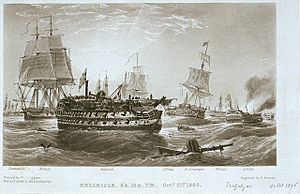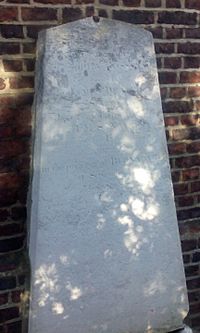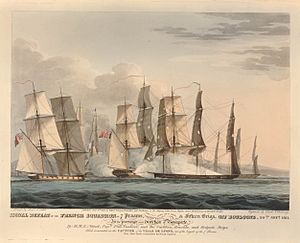HMS Naiad (1797) facts for kids

Naiad
|
|
Quick facts for kids History |
|
|---|---|
| Name | HMS Naiad |
| Builder | Hall & Co., Limehouse |
| Launched | 1797 |
| Commissioned | 1798 |
| Out of service | 1826 |
| Honours and awards |
Naval General Service Medal (NGSM) with clasp "Trafalgar" |
| Fate | Broken up 1898 |
| Notes | Depot ship between 1846 and 1898 |
| General characteristics | |
| Class and type | Amazon-class frigate |
| Tons burthen | 101390⁄94 ((bm) |
| Length |
|
| Beam | 39 ft 5 in (12.0 m) |
| Depth of hold | 13 ft 9 in (4.2 m) |
| Propulsion | Sails |
| Complement | 284 (later 315) |
| Armament |
|
HMS Naiad was a powerful sailing ship called a frigate in the Royal Navy. She was built in 1797 in Limehouse, England, and started her service in 1798. Naiad played a big part in the Napoleonic Wars, which were major conflicts between Britain and France. She was known for capturing enemy ships and even treasure. After her active service, she became a floating storage ship for coal in South America. Naiad was eventually taken apart in 1898, after serving for over 100 years!
Contents
Building and Design of HMS Naiad
Naiad was designed by a famous ship designer named Sir William Rule. She was an improved and larger version of his earlier Amazon-class frigates. This design made her a strong and fast ship for her time.
Early Service in the French Revolutionary Wars
Captain William Pierrepont took command of Naiad in April 1797. Her first years were very busy, capturing many enemy ships.
Capturing Enemy Ships and Privateers
In 1798, Naiad captured several ships, including the French gun-brig Arrogante. She also worked with other British ships like HMS Mars and HMS Ramillies. Later that year, Naiad captured a French privateer called Tigre. Privateers were private ships allowed by their government to attack enemy merchant ships.
One of Naiad's most important captures was the French frigate Décade. Naiad chased Décade for 36 hours before capturing her. The British Navy then used Décade as one of their own ships.
The Rich Capture of Thetis and Santa Brigada
On October 15, 1799, Naiad and other British frigates chased two Spanish frigates. These Spanish ships, Thetis and Santa Brigada, were carrying a huge amount of treasure from Mexico.
- Thetis was captured by HMS Ethalion. She was carrying over 1.3 million Spanish dollars, which was a massive amount of money (about £312,000 at the time!).
- Santa Brigada was captured by HMS Triton, HMS Alcmene, and Naiad. She was carrying even more treasure, about 1.5 million dollars.
The money from these captures was shared among the crews, which was a huge bonus for them!
More Captures and Changes in Command
Naiad continued to capture more French privateers and merchant ships. In December 1800, Captain William H. Rickets took command. In May 1801, Naiad's boats bravely entered a Spanish port at night. They captured a Spanish warship called Alcudia and destroyed another ship, all while under fire from shore batteries.
Fighting in the Napoleonic Wars
After a short break, Naiad was recommissioned in 1802 under Captain James Wallis. She quickly returned to action, capturing more French and Dutch ships.
Successes in the Bay of Biscay
In May 1803, Naiad captured the French corvette Impatiente. This ship was armed with 20 guns. Two days later, she captured a large French merchant ship called Chasseur, which was carrying valuable goods like sugar and coffee.
Naiad continued to capture many ships, including French and Dutch vessels, bringing them into British ports. Her crew was very successful at taking prizes.
The Battle of Trafalgar
In October 1805, Naiad joined Admiral Nelson's fleet near Cadiz, Spain. Nelson was preparing for a huge battle against the combined French and Spanish fleets.
On October 21, 1805, the famous Battle of Trafalgar took place. Naiad was a smaller frigate, so she didn't fight directly in the main battle. Instead, she stayed nearby, ready to help. After the battle, she played a crucial role:
- She helped destroy the Spanish ship Monarca, which had run aground.
- Most importantly, she towed the severely damaged British ship HMS Belleisle to safety in Gibraltar. Belleisle had fought bravely and was almost destroyed.
For their part in the battle, the crew of Naiad received a share of £300,000 from Parliament. Later, in 1847, surviving crew members received the Naval General Service Medal with a special "Trafalgar" clasp.
Continuing Service (1806–1809)
After Trafalgar, Naiad continued to patrol and blockade enemy ports. She captured more ships, including the Kniphausen galliot Vigilante and the American packet ship Margaret Tingey.
In 1808, Naiad was part of the blockade of Brest. She also captured two French privateers, Fanny and Superb, which were trying to attack British shipping.
In 1809, Naiad was part of a squadron that chased French frigates near Les Sables-d'Olonne. The British ships drove the French frigates ashore, where they were destroyed.
Actions Off Boulogne (1811)
In 1811, Captain Philip Carteret took command of Naiad. She was involved in a daring action against a French flotilla of gunboats and praams (large, flat-bottomed boats) off Boulogne.
On September 21, 1811, Naiad and three other British brigs attacked the French flotilla. Naiad managed to separate and capture a 16-gun French praam called Ville de Lyon. This was a tough fight, and Naiad had two men killed and 14 wounded. The British ships drove the rest of the French flotilla back to shore.
Naiad continued to capture more French privateers in the Channel, including the luggers Milan, Reinarde, and Requin.
Later Career and Final Years
After major repairs, Naiad was recommissioned in 1823 under Captain Robert C. Spencer.
Actions in the Mediterranean
In 1824, Naiad visited Algiers to demand satisfaction after a British consul's office was attacked. When leaving the harbor, Naiad encountered an Algerine warship called Tripoli. Naiad attacked and destroyed Tripoli, freeing 17 Spanish people who were being taken into slavery.
Later, Naiad's boats bravely burned another Algerine warship that was hiding under the guns of a fortress.
In 1826, Naiad carried out a mission to Ibrahim Pasha, a general fighting in Greece. She reported on the ongoing siege of Missolonghi. Naiad returned to England and was paid off in October 1826.
Fate of HMS Naiad
From 1846, Naiad was used as a coal depot ship in Valparaiso, Chile, and later in Callao, Peru. This meant she was a floating storage facility for coal, which was used to fuel early steamships.
In 1866, the Pacific Steam Navigation Company bought her. Naiad continued to serve until 1898, when she was finally broken up. This means she was taken apart for her materials. At 101 years old, Naiad was one of the longest-surviving British ships that had been present at the Battle of Trafalgar, second only to HMS Victory.






